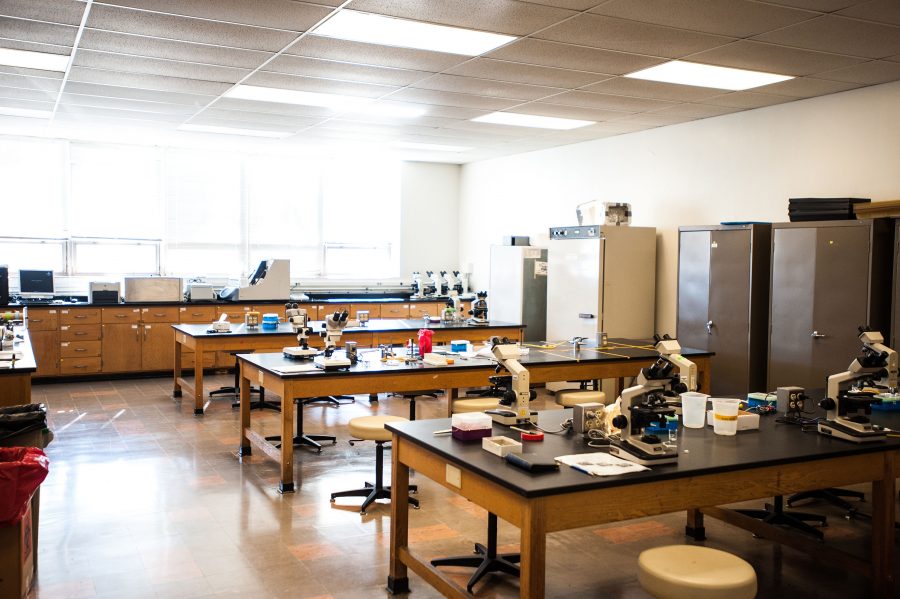Rolling out of bed, Marquette students begin their day, perhaps, by walking into the bathroom and turning on the shower. Once the water turns off, drips from their hair and begins to dry from the shower floor, their hands might next reach to let the water flow from the faucet. Then, throughout the day they seek out water fountains to refill water bottles, on their way passing by bathrooms with toilets flushing and sinks running. Despite its prominence, rarely does it come to mind what is in the water that runs throughout the day.
Water not only hydrates and cleans, but also sustains islands of green in the swath of city streets to bring clean air and places to hang hammocks. But an excess of nutrients can put the health of water, and subsequently home, at risk. Nitrogen and phosphorus, specifically, play a large role in water health as they can lead to issues like that of eutrophication.
Like all living things, plants need nitrogen and phosphorus to survive, and when they don’t receive an adequate amount, fertilizers rich in those nutrients are often applied to soil. Plants then take up the nutrients through their roots to grow taller and stronger. Without nitrogen and phosphorus, plants would be unable to produce the proteins and energy needed to grow.
But a mixture of too much fertilizer and heavy rainfall can pose a problem. Runoff — water that does not get absorbed into the ground — can pull excess nutrients along with it into rivers, says Anthony Parolari, assistant professor of civil, construction and environmental engineering at Marquette. Once in waterways, these nutrients can stimulate the growth of algae. He says its growth uses up oxygen, creating dead zones and leaving aquatic life without the oxygen that is essential to its survival.
“There can be other impacts like when oxygen is low, different bacteria start to grow that don’t need oxygen,” Parolari says. “Those bacteria make hydrogen sulfide, which smells bad. They make methane, which is a greenhouse gas.”
Some algae caused by excess nutrients, such as cyanobacteria, Parolari adds, can also produce toxins that have harmful effects on both the environment and human health.
Milwaukee’s waterways have been victim of algal blooms in the past, according to the Wisconsin Department of Natural Resources.
The Milwaukee River Basin has received grades ranging from D+ to C+ since 2014, receiving a C- in the most recent 2017 assessment. Waters within the C range have “a mix of healthy and unhealthy water quality indicators or indicators are only meeting water quality targets 70 – 79% of the time,” according to the 2017 Milwaukee Water Basin Report Card. This denotes fair water quality and conditions for most aquatic life.
The impact of excess nutrients on waterways have a health, aesthetic and recreational impact, says Cheryl Nenn, riverkeeper at Milwaukee Riverkeeper. As a riverkeeper, Nenn assesses and patrols Milwaukee’s rivers for pollutants or other concerns, and finds solutions to these issues.
Pollution, such as that caused by nutrients, can be dangerous to humans and animals, and Nenn says, is often to blame for beach closings. Additionally, algal blooms and other impacts of pollution can leave waterways unsightly as pollutants kill aquatic life and nearby vegetation.
Nutrient pollution threatens clean waters and can also prevent the enjoyment of beach days and kayak trips down the river.
Ultimately, it comes down to a simple case of all things in moderation.
“Nutrients are interesting because we need them to grow food — we need fertilizers to grow food that we eat — but they’re also considered a pollutant,” Parolari says. “They’re a good thing and a bad thing.”
Marquette uses a nitrogen based fertilizer that is moisture activated, which helps to ensure sufficient nutrient levels with lower rates of application, says Christopher Bartolone, assistant director for facilities services, over email. The product also includes potassium, but no phosphorus. It gets applied once or twice a year, using 4,200 pounds of product each application.
“The university’s turf management program is designed to maximize the environmental benefits of healthy lawns, as well as the overall aesthetic appeal,” Bartolone says.
A possible contributor to nutrient pollution throughout the city, including Marquette’s campus, is construction, says Brooke Mayer, an associate professor of civil, construction and environmental engineering at Marquette.
Construction sites, she says, can alter the infiltration of water. With more soil exposed, it becomes easier for soil and fertilizer to get washed into waterways.
There are rules, however, that minimize the environmental impact of construction sites, Parolari says. Storm grates should have fabric coverings and barriers around them to trap sediment.
An even less glamorous way for excess nutrients to enter our waterways is through pet and human waste, Mayer says.
Under Milwaukee’s streets runs a combined sewer system, a setup that can contribute to the contamination of our waterways from human waste, says Paige Peters, founder and CEO of Rapid Radicals Technology. Peters is a Marquette graduate.
In a combined sewer system, both storm and waste water flow into the same system. During intense storms, which are becoming more common, the sewer system can become overwhelmed and result in water overflow, Peters says. This brings untreated storm and waste water into the streets and directly into Milwaukee’s watersheds.
Rapid Radicals Technology is a product of Marquette’s Water Quality Center and is working on the rapid treatment of storm water to reduce flooding and the contamination of watersheds.
“In Milwaukee we put our waste water in Lake Michigan, and we get our drinking water from Lake Michigan,” Peters says. “We have to constantly be thinking about how those two systems are linked and the connections between them.”
Filtering drinking water, Peters says, is a good way to avoid consuming harmful contaminants, emphasizing the importance of regularly changing filters.
Both an excuse to avoid responsibilities and a way to protect water, Peters suggests no longer equating rainy days with laundry days to lessen the chances of an overflow.
“It doesn’t make a huge impact, it might not seem like it is, but it’s changing the way you think every single day,” she says. “And that is huge.” While it may not seem to have a large impact on the environment, Peters says small habitual changes like laundry day can help us to shift the way we see the environment and how we function within it.
Peters says Milwaukee is an industrial town that used to use the river as its own sewage release. “And that was a really long time ago, but it takes a long time for these systems to heal.”
Ways to prevent nutrient pollution and increase water quality generally might include bans or restrictions, Mayer says. Fertilizers are becoming more regulated with cities like Minneapolis and Madison, Wisconsin, introducing restrictions on lawn fertilizers, she says.
While fertilizers and nutrient pollution can be an issue on any managed land, urbanization presents unique challenges. In addition to an abundance of buildings and impermeable roadways, soils can become compacted when equipment drives over it, preventing infiltration, increasing runoff, thus causing pollution, Parolari says.
However, all is not lost once nutrients have entered the water. Nutrient recovery, Mayer says, can be used to pick out nutrients from waste water and turn them into different forms, such as fertilizers.
Additionally, Parolari says, we are now shifting from simply paving over everything and building storm water systems meant to move water as quickly as possible to working to protect greenspace.
“Engineers are starting to develop systems that sort of rely on these plants and these soils to actually retain the nutrients, or retain the pollutants,” Parolari says. “We’re using greenspace now as a pollutant mitigation mechanism.”
Parolari says he thinks it’s all about tradeoffs. Similar to the dichotomy of the impact of nutrients, adding greenspace can be a good thing but can also introduce issues like pollutants. Researchers, he says, (at MU?) have found that green roofs like the one on Engineering Hall can be a source of phosphorous to streams because it introduces a new site full of compost and nutrients.
He says the soil of the Victory Gardens near the Alumni Memorial Union tend to have a high amount of nutrients because the plants need to grow, but this can also be a source of excess nutrients.
“This is really what we are trying to figure out now,” Parolari says. “How much greenspace can you have? How do you choose the right mix? What are the tradeoffs?”
As Marquette’s campus continues grow, this balance of greenspace is inevitably going to be altered for better or worse. But as long as they are managed appropriately, Mayer says she believes the benefits of increasing greenspace will outweigh any negatives.
“Greenspaces are not inherently bad…Going back to are we applying fertilizers onto them, or are we gathering a lot of organic matter like leaves and grass clippings and leaving them on site?” Mayer says. “The benefit is probably a lot more than any sort of drawback that you would ever see because you have the infiltration and natural cycling.”





